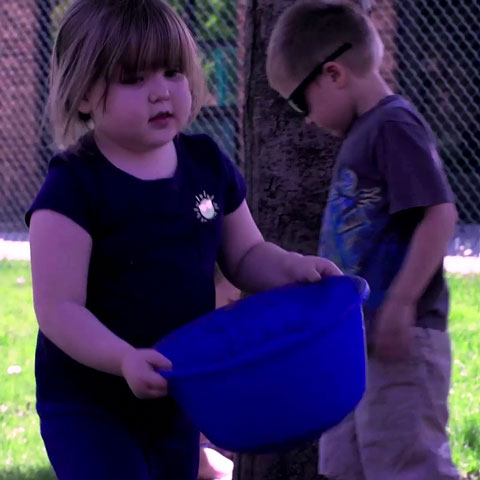About this video
The open-ended characteristic of natural elements such as leaves, sand, and rocks can spark children’s imaginations. Outdoor playtimes are an opportunity for children to participate in pretend play while they are busy running, climbing, and enjoying the benefits of fresh air and sunshine. Sometimes a simple object such as a bucket, stick, or cup can spark a child’s imagination and lead to complex dramatic play with peers. These objects can be imbued with a special role in the story and the prop can promote extended engagement in play.
In this video, we see a large blue mixing bowl spark children’s interest and lead to this type of complex play. The children work together in a group to reach a common goal of making “soup” in a bowl. They explore the outdoors and find several materials to put in the blue bowl for their “soup.” This play is a rich opportunity to develop their language skills. The children use their language skills to label, describe, give commands, ask questions, and answer questions.
The video provides highlights of this dramatic play episode, which lasted for about a half hour. Though we mainly see Fawn, age 4; Aaron, age 3; and Sam, age 5, playing with the bowl, we also see other children join as they pass by the three making the “soup.”
The children’s conversations become more complex as they negotiate what is needed to feed the animals they are pretending to care for in their story. These pretend play times involve speaking, listening, and storytelling. They are important for building a foundation of oral language skills that are foundational for young children’s early literacy learning.
Video
Transcript
Fawn: I need grass.
Aaron: Yeah. And some of these.
Fawn: Yeah.
Aaron: And some of these.
Fawn: Oooh. And some of these.
Fawn: Oooh.
Aaron: And some of these.
Fawn: Some of these.
Sam: What are you doing?
Fawn: I’m collecting (unintelligible) for my (unintelligible).
Children talk at same time.
TRANSITION AT 0:58
Child in background: Don’t. Don’t climb it. Don’t climb trees.
John: That’s it. We’re not really trying to break the branch. We’re just trying to get these leafs.
That’s all.
Child in background: Don’t you climb.
TRANSITION AT 1:12
Fawn: One, two.
Child in background: Now let’s leave it right now.
Child says something unintelligible.
Fawn: Okay.
TRANSITION AT 1:18
All children talking at same time.
Fawn: Put some more.
Then go hang.
Boy: Put some more.
Child in background: You want more leaves?
Child in background 2: No.
Child in background: Well that means you can touch it.
Child in background: Cause if you only want (unintelligible).
Don’t break it.
Child in background 2: Why?
Child in background: Only leafs. Do you want one?
Child in background 2: Yeah.
Child in background: Let’s try these.
Child in background: Which one?
Child in background 2: This one?
Child in background: Yes.
TRANSITION AT 1:55
Fawn: Ohh.
Fawn makes sounds with her mouth.
Teacher: You have enough leaves. Where did the leaves go that you pulled?
Child in background: Hey. Hey. You want some of dirt?
Aaron: Hey
Sam: What?
Garbled crosstalk.
TRANSITION AT 2:14
For six seconds there is no sound because children’s names were dubbed out.
Boy in background: (Child’s name), come to the playground.
Child in background: No, no, no.
Fawn: The leaf is on your head.
TRANSITION AT 2:38
Fawn: I’m picking the rocks up … in here.
Yummy in the …
Children talk unintelligibly.
Fawn: Oooh. Can we put sand in it?
Boy in background: Glasses in my head. Glasses in my head.
Teacher: Do you have glasses on your head?
Child in background: No. Eaves is on my head.
Teacher: Leaves on my head.
Fawn: Now let’s put things in it.
Children talking at same time.
Benchmarks and How They Were Met
| Benchmarks | How They Were Met |
|---|---|
| Language Arts 1.B.ECa: Use language for a variety of purposes. 1.B.ECc: Continue a conversation through two or more exchanges. | The children use language for a variety of purposes by labeling the materials they are using and describing their actions. They also engage in conversation about the task of filling their blue bowl. They ask each other questions, respond to one another, and respond to the teacher’s questions. |
| The Arts 25.A.ECb: Drama: Begin to appreciate and participate in dramatic activities. | The children engage in pretend dramatic play. They use outdoor materials such as leaves and rocks as ingredients in their soup. One child even says “yummy” while she is adding some ingredients. |
| Social/Emotional Development 31.B.ECa: Interact verbally and nonverbally with other children. 31.B.ECb: Engage in cooperative group play. 31.B.ECc: Use socially appropriate behavior with peers and adults, such as helping, sharing, and taking turns. | As the children use their growing communication skills, they work collaboratively together to fill the blue bowl and make “soup.” The children help each other to reach a common goal and take turns putting materials into the bowl. |


